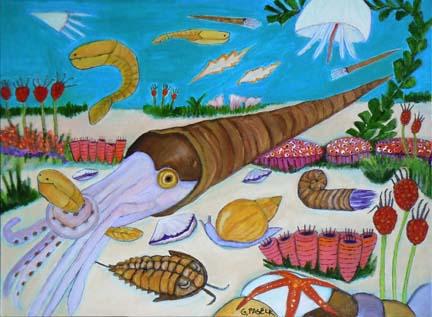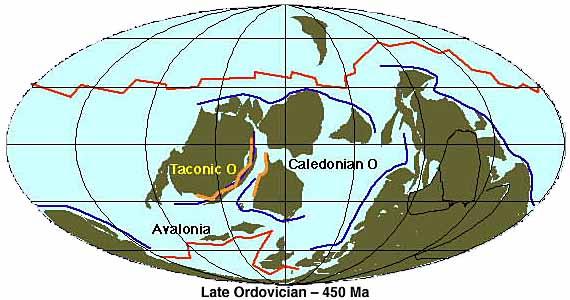
Ordovician Radiation
© G. Paselk
Artist’s depiction of the rich fauna of the Ordovician. Animals include, from left: Cystoids, jawless fish (Sacabambaspis) captured by a large cephalopod (Endoceras), Rugose corals, brachiopods, trilobite, gastropod (Cyclonema), a sea star and coiled cephalopod. Jellies, small nautiloids & graptolites (Orthograptus) are seen to the left.
488.3 to 443.7 Million years ago
Richard Paselk
Plate Tectonic Reconstructions


These maps of major tectonic elements (plates, oceans, ridges, subduction zones, mountain belts) are used with permission from Dr. Ron Blakey at Northern Arizona University. The positions of mid-ocean ridges before 200 Ma are speculative. Explanation of map symbols.
The Ordovician* lasted about 45 million years and saw the transition from very primitive to relatively modern life-forms in the seas. The “Ordovician radiation” which followed the late Cambrian extinctions, lead to a tripling of marine diversity, the greatest increase in the history of life, and giving the highest levels of diversity seen during the Paleozoic Era. As a result, all of the common invertebrate fossil groups and a few vertebrates were present by the end of this period. Starfish, brittle stars, crinoids, and echinoids, all of which have living representatives, first appeared in the Ordovician. In the evolutionary history of animal life this radiation was second only to the “Cambrian explosion” in importance. The new Paleozoic fauna created by the “Ordovician radiation” dominated the seas for the next 230 million years. Pandemic species of planktonic graptolites and conodontes appear in the fossil record during this Period. Their world-wide distribution and evolution during the Ordovician make them key species for correlating fossil deposits. Unlike in the Cambrian, most animal evolution in the Ordovician involved refining existing body plans rather than developing new ones. Bryozoans, the last animal phyla to appear in the fossil record, have the only new body plan, and they may have evolved in the Cambrian, but only became mineralized, and thus left fossils, in the Ordovician.
The Ordovician saw the replacement of the Cambrian marine fauna composed largely of deposit feeders, such as trilobites, with the Paleozoic fauna dominated by filter feeders arranged in tiers. Tiered suspension feeder communities attached to the sea floor dominate the new Paleozoic ecosystems: brachiopods filter bottom waters, corals and branched bryozoans filter water just above, and crinoids filter water at the highest level. The Paleozoic fauna was also characterized by a move away from the interface of the ocean and ocean floor—animals both learned to bore deeper into the substrate and to invade the pelagic (in the water column ,not on shore or the bottom) regions of the oceans. Grazing gastropods increased in importance while efficient predators like sea stars and cephalopods evolved. Remnant Cambrian fauna, such as deposit feeding worms and trilobites, continued with diminishing importance throughout the Paleozoic.
Tectonically, the Ordovician saw a rapid reorganization of plates around the Iapetus Ocean. Today’s southern continents were fused into the supercontinent of Gondwana, while others remained independent. Plate movement resulted in a migration of Gondwana from an equatorial position toward the South pole, as a result the South Pole moved from North Africa to central Africa. The movement of Gondwana to the South Pole resulted in global cooling and the most severe ice age of the Phanerozoic Eon. Sea levels rose through much of the Ordovician to the highest sea levels of the Paleozoic before receding. The period ended with a strong lowering of sea levels (a strong negative eustatic event) as high latitude glaciation occurred.
There were significant fluctuations in climate with prolonged periods of warm “hothouse” conditions with periodic cold, “icehouse” intervals and turnovers of the oceans. High levels of CO2 early in the Period lead to very high temperatures—oceans may have reached 113°F (45°C). These high temperatures may have delayed animal diversification in the early Ordovician. Later, ocean temperatures decreased gradually to those seen in modern equatorial waters. The Ordovician ended with the second greatest extinction event of the Phanerozoic Eon. Two massive reductions, a million years apart, created this event—resulting in the extinction of more than 60% of invertebrates. This event is associated with sea level changes and glacier formation. Only the great Permian extinction event was more devastating to Earth’s biosphere.
* The term Ordovician was proposed by Lapworth in 1879 for strata which had been included in Cambrian or Silurian systems. It is named for the Ordovices, a tribe of northern Wales.
Ordovician Animal (Metazoan) Fossils
Trilobites
(ToL: Trilobites<Arthropoda<Ecdysozoa<Bilateria<Metazoa<Eukaryota)

Trilobites
A rich new fauna of trilobites appeared in the Ordovician contributing to the significant on-going Cambrian fauna. Nine specimens representing six genera are displayed:
 Calymene callicephala
Calymene callicephala Cryptolithus tessalatus
Cryptolithus tessalatus- Flexicalymene
 Flexicalymene meeki
Flexicalymene meeki Flexicalymene meeki
Flexicalymene meeki Flexicalymene sp. (enrolled), and
Flexicalymene sp. (enrolled), and Flexicalymene sp. (a second enrolled example)
Flexicalymene sp. (a second enrolled example) Homotelus bromidensis
Homotelus bromidensis Isotelus sp.
Isotelus sp. Pseudogygites canadensis
Pseudogygites canadensis
Echinoderms
(ToL: Echinodermata<Deuterostomia<Bilateria<Metazoa<Eukaryota)

Sea stars
Sea stars (Asteroidea) such as our specimen, as well as their relatives, the Brittle stars (Ophiuroidea) first appear during the Ordovician.

Crinoids
Crinoids (Crinoidea) also first appear in this Period They are represented in our collection by

Edrioasteroids
Edrioasteroids (Edrioastroidea), were an extinct , round, sessile form of echinoderm . Compare the short thick, plate-covered stalk on our specimen to the engraving above. The five rayed feeding grooves, which often make these organisms look like starfish, are damaged but discernable.
 Isorophus cincinnatiensis (attached to a brachiopod shell)
Isorophus cincinnatiensis (attached to a brachiopod shell)
Graptolites
(ToL: Hemichordata <Deuterostomia<Bilateria<Metazoa<Eukaryota)

Graptolites
Graptolites were strange colonial animals with a plant-like appearance in their fossils. They are thought to have been members of the Hemichordata. Two specimens are displayed:
![]() saw toothed shaped: The first has three species on the same slab. All three share asaw toothed appearance but they differ in branching pattern.
saw toothed shaped: The first has three species on the same slab. All three share asaw toothed appearance but they differ in branching pattern.
 blade shaped: The second specimen shows blade shaped graptolites, probably as a result of compression into a 2-dimensional plane.
blade shaped: The second specimen shows blade shaped graptolites, probably as a result of compression into a 2-dimensional plane.
Fish
(ToL: Vertebrata<Chordata<Deuterostomia<Bilateria<Metazoa<Eukaryota)

Ostracoderms
Ostracoderms (Ostracodermi), represented in our collections by a small skull, were primitive jawless fish without paired fins. They were armored with a coat of large bony plates or scales. They were the first fish to use their gills for breathing only, feeding with pharyngeal gill pouches. Originating in the Ordovician, they began a decline with the advent of jawed fish, dying out with the end Devonian extinction event.
Mollusks
(ToL: Mollusca<Lophotrochozoa<Bilateria<Metazoa<Eukaryota)

Gastropods
Gastropods (Gastropoda) were small and rare during the Cambrian, but they became a diverse and sometimes large bodied group in the Ordovician. Two medium sized snails, genus Salpingostoma, represent this group in our collection.
 Salpingostoma with trilobite
Salpingostoma with trilobite

Cephalopods
Cephalopods (Cephalopoda), like their relatives the gastropods, diversified and grew in size in the Ordovician. These relatives of modern squids were one of only two families of animals (starfish are the other) that appear to have been predators. All other animals at this time seem to have been detritus feeders, filter feeders, or grazers. Four specimens are displayed;
![]() nautiloid fragment, straight cone-shaped
nautiloid fragment, straight cone-shaped
 nautiloid fragment, straight cone-shaped
nautiloid fragment, straight cone-shaped
![]() Liluites lituus, partially coiled cephalopod
Liluites lituus, partially coiled cephalopod
Liluites lituus The mural specimen of this partially coiled cephalopod is found on the touch shelf on the Mississipian case.
Brachiopods
(ToL: Brachiopoda<Lophotrochozoa<Bilateria<Metazoa<Eukaryota)

Brachiopods
Brachiopods are the dominant fossils in Ordovician deposits, as seen in three assemblages:
 seafloor assemblage—also includes bryozoan, coral, annelid, and gastropod fossils. (Can you find them?)
seafloor assemblage—also includes bryozoan, coral, annelid, and gastropod fossils. (Can you find them?)
![]() brachiopod assemblage—brachiopods and their fragments dominate
brachiopod assemblage—brachiopods and their fragments dominate
![]() Plaesiomys subquadrata—a single species is present.
Plaesiomys subquadrata—a single species is present.
Individual specimens include:
![]() Rhynchotrema sp. (note the solitary coral attached to one of the shells)
Rhynchotrema sp. (note the solitary coral attached to one of the shells)
Corals
(ToL: Cnidera<Metazoa<Eukaryota)

corals
The corals appear in the fossil record for the first time early in the Ordovician:
- The tabulate colonial corals are the first corals to appear in the fossil record, two examples are displayed:
- The rugose corals appear by the Middle Ordovician. On display are specimens of solitary rugose corals
 An unidentified solitary coral may be seen growing on the shell of a brachiopod, Rhynchotrema sp.
An unidentified solitary coral may be seen growing on the shell of a brachiopod, Rhynchotrema sp.
The engravings of Ordovician fossils are from Dana, James D. (1870) Manual of Geology, or Encyclopedia Britannica, 11th ed. (1911).
Last modified 10 August 2012 | ©1998, Cal Poly Humboldt NHM


 Iocrinus subcrassus
Iocrinus subcrassus Salpingostoma richmondense
Salpingostoma richmondense Hebertella sinuata
Hebertella sinuata Platystriophia acutilirata
Platystriophia acutilirata Strophomena neglecta
Strophomena neglecta Foerstiphyllum vacua
Foerstiphyllum vacua Foerstiphyllum vacua
Foerstiphyllum vacua Streptelasma
Streptelasma